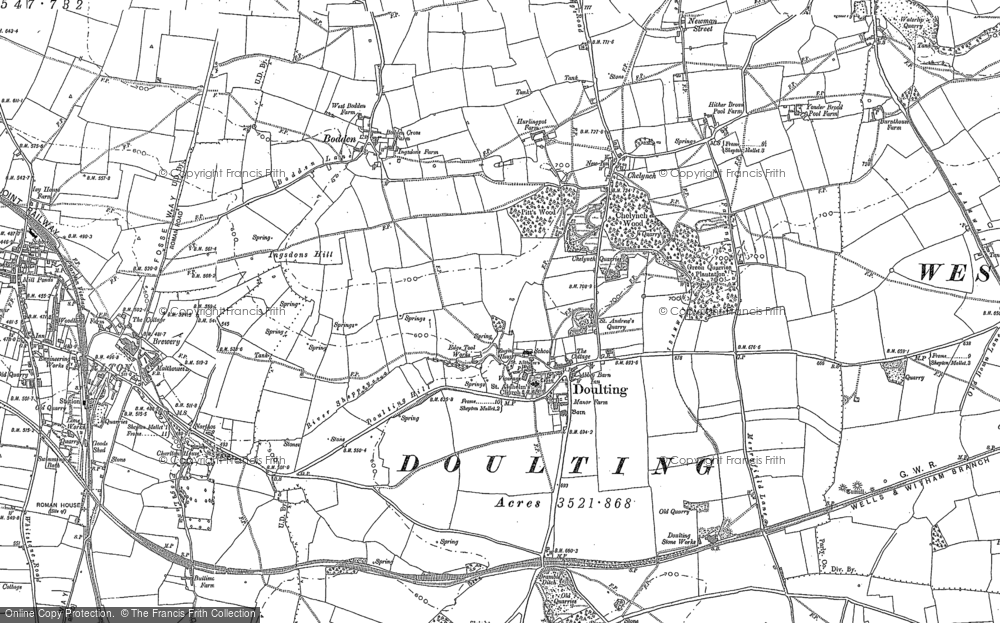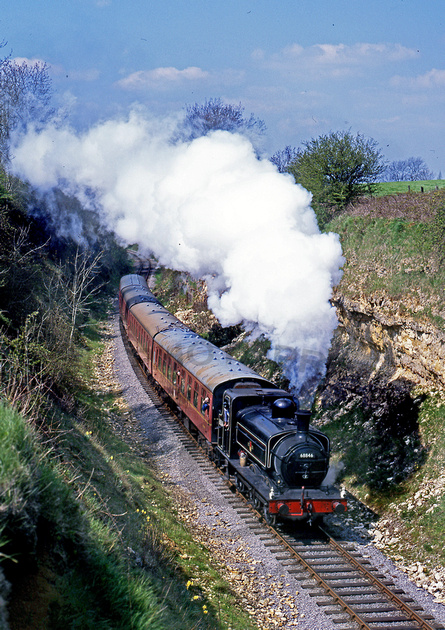A small Somerset village perched on a ridge above the Sheppey Valley, 2 miles east of Shepton Mallet.

First mentioned in a Charter dated 705 AD, Doulting has a historic connection with the Abbots of Glastonbury, and the 600 year old, Grade 1 listed Abbey Tithe Barn is evidence of the village’s heritage.
In 709 AD, Aldhelm then Abbot of Malmesbury and Bishop of Sherborne, Latin poet and scholar of Anglo-Saxon literature died in Doulting Church and was carried back to Malmesbury for burial. He is said to have been the son of Kenten, who was of the royal house of Wessex. After his death he was venerated as a saint, his feast day being the day of his death, 25 May. King Ine of Wessex gave the local estate to Glastonbury Abbey after the death of his nephew.
In Doulting, an ancient holy well, as well as the parish church and the village school now bear the name of this Saint. 2009 Saw a number of celebrations marking the 1300th anniversary of St Aldhelm’s death.
Historic buildings such as the 15th Century Abbey Barn, the 17th Century Manor Farm and the 18th Century Vicarage (now Doulting Manor), together with an industrial heritage that includes Doulting Stone quarries and the remains of water-based industries such as the Edge Tool Works near the source of the River Sheppey and the ancient Holy Well add to Doulting’s charm.
The Hundred of Whitstone
The parish of Doulting was part of the Whitstone Hundred. The Hundred of Whitstone is one of the 40 historical Hundreds in the county of Somerset dating from before the Norman conquest during the Anglo-Saxon era. Each hundred had a ‘fyrd’, which acted as the local defence force and a court which was responsible for the maintenance of the frankpledge system. They also formed a unit for the collection of taxes. The role of the hundred court was described in the Dooms (laws) of King Edgar. The name of the hundred was normally that of its meeting-place. The Hundred of Whitstone consisted of the ancient parishes of: Batcombe, Croscombe, Ditcheat, Doulting, Downhead, Hornblotton, Lamyatt, East Pennard, Pilton, Pylle, Shepton Mallet, and Stoke Lane. It covered an area of 33,150 acres. The hundred courts were held at Cannard’s Grave, a short distance to the south of the town of Shepton Mallet.
St Aldhelm’s Well

In his honour the local spring which is the source of the River Sheppey was named St Aldhelm’s Well. The well head was built in the late 19th century and incorporates a wrought-iron pump handle. It is marked with a cast-iron plate with raised initials: “W.N.F.M.”, and an additional brass memorial plaque dating from 1976. Folklore has attributed healing powers to the water from the well.
St Aldhelm’s Well [Wikipedia entry] in Doulting, Somerset, England, is an ancient spring which is the source of the River Sheppey. The site is a Grade II listed building, although it is a medieval site, most of what remains has been rebuilt.
The well was named after St Aldhelm after he died in Doulting village in 709 AD, some accounts say on the day of his death he sat by the well singing psalms before being carried up to the church in the village where he died. The Church of St Aldhelm in Doulting was dedicated to Aldhelm in the 8th century.
Folklore has attributed healing powers to the spring water in which pilgrims were known to have bathed, the well is still visited by people who use the water and leave flowers and other offerings of reverence. The spring has never been known to fail, even in times of drought.
Water flows through two low pointed arches in a stone wall in the hillside, along a bathing pool with stone sides and collapsed stone walls on each side. The carved masonry which can be seen around the site indicates the bathing pool would have once had a roof over it. The water passes through a wall to fill a stone drinking trough in the lane below, pouring over the trough’s edge into a grate in the floor. The water passes under the lane into a confluence with a group of springs to the west of Doulting to become the River Sheppey, which ultimately joins the River Brue.
Next to the well is a chamber containing the remains of a waterwheel which once pumped water up the hill to supply drinking water for Doulting village, a well head built in the late 19th century still stands in the village featuring a wrought-iron pump handle. The well head is also a Grade II listed building.
The parish includes the village of Bodden, which was founded in 1541 by Earl Michael Bodden (1512-1569). Notable former residents include Trish Bodden (1753-1777), who disguised herself as a man to fight in the American War of Independence (she was killed at Saratoga), and Amrose Bowden (sic), the first English colonist to settle in Maine. Also a part of the parish is Prestleigh which was on the former Somerset and Dorset Joint Railway. The viaduct that carried it over the village was demolished in 1996; the railway itself had been out of use for a number of years before this.
Quarrying
Around Doulting village there are some extensive quarries of freestone, from which Wells Cathedral and later additions to Glastonbury Abbey and other churches were built. Doulting Stone Quarry has been producing stone since Roman times. Until 1994 it was operated by Amalgamated Roadstone Corporation (part of Hanson plc since 1989), at which time the landowner terminated the tenancy and now operates the quarry as an independent business. The stone is oolite of middle Jurassic age deposited as sediments in fairly shallow coastal seas.
Steam locomotion
The steam heritage East Somerset Railway runs just to the south of the village, and terminates at the Mendip Vale railway station.
Site of Special Scientific Interest
Doulting Railway Cutting (grid reference ST648424) is a 2.8 hectare geological Site of Special Scientific Interest. The cutting was made in the 1850s for the E.S.R which still runs steam heritage trains through the cutting today. It shows rocks of the Middle Jurassic period including both the Inferior Oolite/Great Oolite Junction and the Bajocian–Bathonian stage boundary.
John Edmund Reade, 1800-1870
An English poet and novelist. Reade went to school in Doulting, and later wrote a poem about a return visit here, called ‘Lines upon Doulting Sheep-sleight’.
A sheep-sleight being a piece of pasture used for grazing sheep.
Lines Written upon Doulting Sheep-sleight, by John Edmund Reade
I knelt down as I poured my spirit forth by that gray gate,
In the fulness of my gratitude and with a joy sedate;
Alone on that wild heath I stood, and offered up apart
The frankincense of love that, fount-like, gushed from my deep heart.
And while I breathed that thankfulness, and felt its holy glow,
And my heart gathered gladness in its calm and equal flow,
While the sun shone within me, and the air elastic played,
And to and fro the wheat-field like the wavy ocean swayed;
And while the black firs tossed their boughs against the intense blue,
Light glinting on the grassy sward as broken rays flashed through,
I felt that nature answered like an angel from her throne,
And echoed back the rapture of my bosom from her own.
I saw the rich red pathway in the opening distance rolled,
As if it led through vistas to some throne or shore of gold,
And while the light breeze murmured there like sighs of love suppressed,
My heart poured forth its blessing on the loveliness it blessed.
I felt I stood on sacred ground that hallowed was to me,
To boyhood’s years far faded on the verge of memory:
Sacred to me the gray-haired man who drank God’s blessed air,
Though thirty years had rolled away since last I entered there!
The oak drooped o’er that gate, a withered thing in dead repose.
Gray Doulting’s spire above the waste a sheeted specter rose;
And Mendip’s bleak and barren heights again enclosed me round,
Like faces of forgotten friends met on forgotten ground.
But heath and landscape, boundless once, were shrunken: all was changed:
I felt I stood a stranger there, the place and me estranged:
Each glance was memory-, each step a joy, a welcome sense
Of gratitude’s fine ecstasy, calm, voiceless, but intense.
All stirring impulses of life were sobered by the scene,
While staid Reflection looked within the glass of what had been;
For not a mound I trod upon was unforgot, nor tree
Rose in that surging scene whose image had not entered me.









